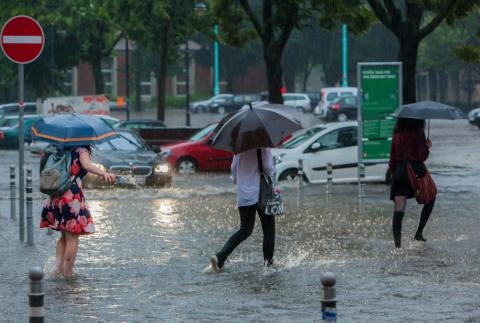A new study has examined how high-impact weather in the UK, such as extremely hot days, heavy rainfall and very cold conditions, could be affected at different levels of global warming.
The study, published in the journal Climatic Change, found that the higher the level of global warming, the projected increase in frequency or severity or both will be stronger for hot weather, droughts and flooding in the UK. These high-impact weather events can cause significant disruption across the UK affecting sectors such as health, transport, agriculture and energy.
Key findings from the paper include:
- The number of extremely hot days in the UK could increase four-fold
Currently days exceeding 25.0°C could rise from around 10 days a year now (range 8-11 days) to 37 days (range 32-46 days with a 4.0°C rise in global warming. With a 2.0°C rise in average global temperature the number of days exceeding 25.0°C is calculated to be 18 days per year (range 15-22 days). Posing increasing risk to human health from extreme heat. - The number of days of high-impact heavy rainfall in the UK leading to severe weather warnings could rise by three days per year
Currently, there are around 7 days per year (range 6-9 days) in England and Wales with intense and prolonged rainfall that could lead to river flooding. With a 4.0°C rise in global temperature this could rise to 11 days per year (range 10-13 days). Under a 2.0°C rise in global temperature it is expected England and Wales will receive 9 days per year (range 8-10 days) of intense and prolonged rainfall. - The number of days were temperatures fall below 0.0C are likely to become less frequent
Currently there are around 50 days (range 45-56 days) per year where temperatures dip below 0.0°C each year in the UK. In a world that has increased to 4.0°C, the UK would expect to record 12 days (range 9-21 days) per year. With a 2.0°C rise we’d expect to see around 34 days (range 27-44 days) per year. - More frequency and severe long-term droughts, with droughts at least as severe as seen in 2010 increasing by 146%,at a 4.0°C level of global warming and 86% more frequent by 2.0°C.
Lead author Dr Helen Hanlon, from the Met Office, said: “Our research clearly shows that the more we warm the planet through human-induced climate change, the more severe weather we can expect in the UK. Severe weather can impact us in a number of ways, from our health, to flooding, food availability and transport issues.
“Importantly, the paper shows that the increase in high-impact weather is reduced if global warming is kept as low as possible, showing that efforts to reduce human-induced climate change will curb the most severe impacts of future weather in the UK.”
With changes evident at even 1.5°C of global warming this is a reminder that even with the most optimistic global emissions mitigation scenarios there is still a need for adaptation, long-term planning and risk assessment activities across sectors in the UK.
The authors used simulations from the UKCP18 12km high resolution ‘Regional Climate Model’ and found that the UK can expect an increase of hot days (where temperatures exceed 25°C), with at least 5 additional hot days per year at a 1.5°C level of global warming and up to 39 additional hot days per year at a 4.0°C level of global warming. This increase in frequency, future summers are projected to become hotter, and adaptation will be more important to mitigate risk to human heat from extreme heat.
An increase of high-impact rainfall days is also projected, with at least 1 additional day per year at a 1.5°C level of warming and up to 8 additional days per year at a 4.0°C level of global warming. Suggesting more frequent river flooding having widespread severe impacts across the UK.
As well as severe rain, the UK can expect an increase in the frequency and severity of long-term droughts, with droughts at least as severe as seen in 2010 increasing by 146%, at a 4.0°C level of global warming. 2010 is in the top 10% of driest years in the UK since 1862. Adaptation of water management practices can expect to be required to cope with increased severity of drought.
The likelihood of cold conditions is also impacted, with at least 10 fewer days per year where temperatures fall below 0.0°C at a 1.5°C level of warming, and up to 49 fewer days per year at a 4°C level of warming. This would mean less cold-weather disruption due to lower than normal chance of ice and snow.
The research has recently been comprehensively cited in the UK’s third Climate Change Risk Assessment (CCRA3), compiled by the Climate Change Committee. The Risk Assessment technical report makes frequent use of the findings from this research.
As well as causing future impacts, human-induced climate change has already influenced extreme weather in the UK. Research has shown climate change made the 2018 record-breaking UK summer temperatures about 30 times more likely than it would be naturally. Additionally, a separate study found that extreme heavy rainfall like the record rainfall observed on 3 October 2020 would in a natural environment, with no influence from human-induced climate change, be a 1-in-300-year event, it is now a 1-in-100-year event in the current climate.
Professor Jason Lowe OBE, from the Met Office and Priestley International Centre for Climate at the University of Leeds, said: “This study provides part of the picture for what our future weather and climate may look like. Crucially it sits alongside other studies, such as those examining the risks from wildfire and floods, helping to create as full a vision of the future as possible. The more insight we have on our future world, the more opportunity there is to plan for it.”

